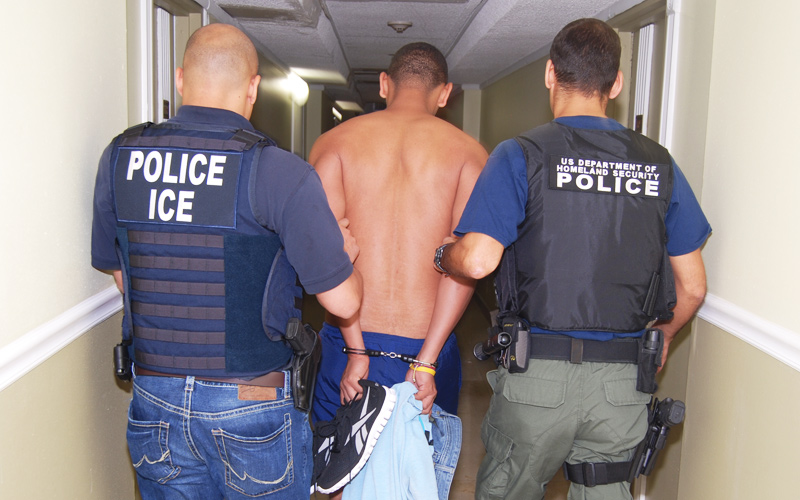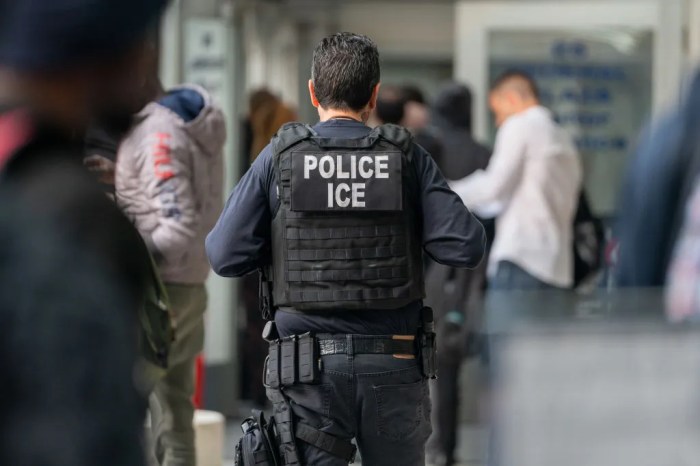By Ginger Thompson and Marcelo Rochabrun, ProPublica
Buried deep in the Trump administration’s plans to round up undocumented immigrants is a provision certain to enrage Mexico — new authority for federal agents to deport anyone caught crossing the southern border to Mexico, regardless of where they are from.
If present immigration trends continue, that could mean the United States would push hundreds of thousands of Guatemalans, Hondurans, Salvadorans, Brazilians, Ecuadorans, even Haitians into Mexico. Currently, such people are detained in the U.S. and allowed to request asylum.
President Trump wants them to do so from Mexico, communicating via videoconference calls with U.S. immigration officials from facilities that Mexico would presumably be forced to build.
“This would say if you want to make a claim for asylum or whatever we’ll hear your case but you are going to wait in Mexico,” a DHS official said. “Those are details that are being worked out both within the department and between the US government and the government of Mexico … there are elements that still need to be worked out in detail.
Kelly and Secretary of State Rex Tillerson will travel to Mexico later this week to meet with representatives of the Mexican government. It remains unclear if they will discuss this issue.
The new authority for immigration agents is among the dramatic, some would say untenable, tactics the Trump administration is preparing to deploy as it upends President Obama’s policies on illegal immigration.
A pair of memos signed by John Kelly, the Homeland Security secretary, and publicly released on Tuesday outline the plans for what present and former government officials say will be a massive roundup of undocumented immigrants. Near final drafts of the memos had leaked over the weekend and had been first reported by McClatchy.
Officials disclosed that two former Senate aides to Attorney General Jeff Sessions drafted the plan without input from career DHS policy staffers. The ideas aren’t new. Many of the approaches described in the memos come from a 1996 law that policy makers and law enforcement agents had disregarded as either unenforceable or absurd.
“Most of these provisions of law have been there for decades,” the DHS official said. “We are simply trying to execute what Congress has asked us to do.”
Among them was the Mexico part of the plan, for example, which calls for returning undocumented immigrants “to the foreign contiguous territory from which they arrived.” The memo goes on to point out how foisting the immigrants onto Mexico would benefit DHS’s budget, saying that it would, “save the Department’s detention and adjudication resources for other priority aliens.”
However, former senior Mexican and American immigration officials said it could very well create new security problems along the border, as authorities in each country push unwanted migrants back and forth.
The American Immigration Lawyers Association said that the proposal would violate U.S. law and international treaty obligations. Mexico is as likely to embrace the plan as it did the notion of paying for a wall. “I would expect Mexico to respond with an emphatic ‘No,'” said Gustavo Mohar, a former senior Mexican immigration and national security policy official.
Whether viable or not, the Trump administration’s deportation plans mark a dramatic departure from decades of policy and practice. Current and former immigration policy officials say that while the details of how the administration intends to carry out the plans remain unclear — if not insurmountable — the administration’s overall message to enforcement agents across the country is clear: the limits have been lifted.
President Obama attempted to focus enforcement efforts on immigrants who had been convicted of serious crimes, and on those who were caught while or shortly after illegally entering the country. Still, his administration deported record numbers of immigrants, most of whom had only been accused of minor crimes and immigration violations.
The Trump administration says it, too, is focused on deporting criminals, but it has redefined crimes to include any activity that might bring a conviction, including entering the U.S. without permission. Effectively, that makes virtually everyone in the U.S. without a proper visa subject to roundup at their workplace or home.
“If you are present in the U.S. without being admitted or paroled or having overstayed your visa, the immigration laws of the U.S. subject you to removal,” the DHS official said. “Everyone who is in violation of the laws is theoretically subject to enforcement. The Department has limited resources and we will, to the extent that we can, focus on folks who have committed serious crimes.”
The only clear exception, according to the enforcement plan and the DHS briefing, is for immigrants who were illegally brought to the U.S. as children, known as Dreamers.
“Anyone who complained about Obama as the deporter-in-chief,” said David Martin, formerly DHS’s principal deputy general counsel, “is unfortunately going to get a taste of what it’s like when someone is really gung-ho.”
Greg Chen, the policy director at AILA, said the Trump plan would “effectively unleash a massive deportation force with extremely broad authority to use detention as the default mechanism for anyone suspected of violating immigration law.”
The question looming over the proposals is how many of them, with all their legal and logistical obstacles, will the president actually be able to carry out.
The memos, for example, authorize the Border Patrol to hire 5,000 new agents, even though the force has never been able to fill the slots it has already been allotted. Some 60 percent of applicants to the Border Patrol fail the required polygraph, and those who pass take 18 months to get sent out into the field.
The Trump plan calls for the expansion of a George W. Bush-era program, known as 287g, which allows DHS to deputize state and local police as immigration agents. It was touted after 9/11 as a critical “force-multiplier.” But by 2010, some of the country’s largest police departments were refusing to participate because they believed it would shatter the trust between their officers and the communities they were sworn to protect. Meanwhile, participating agencies, which foot the bill for the program, were suddenly saddled with new debts and hounded by accusations of racial profiling and other abuse, forcing the Obama administration to suspend expansion of the program.
Until now, the enforcement of summary deportation laws, known as “expedited removal,” have been limited to those apprehended within 14 days of illegally entering the country and within 100 miles of Canada or Mexico. The memos signed by Kelly would allow use of those laws anywhere in the country against anyone who entered illegally within the past two years.
Lucas Guttentag, a former DHS adviser and Stanford law professor, said this would “unleash chaos,” violate due process, and meet challenges in court, similar to those that scuttled the administration’s travel ban.
There would also be aggressive challenges, lawyers said, to plans that would allow immigration agents to deport unaccompanied minor children who crossed the border illegally, rather than uniting them with parents or other relatives in the U.S.
The reason for discussing unaccompanied minors is ” that they have been abandoned by their parents or legal guardians,” the DHS official said. If it is “determined that there is a parent or guardian in the U.S. that they can be handed over to, then DHS needs to take a hard look over whether that person is actually” an unaccompanied minor.
“There will be a renewed focus on ensuring that folks don’t abuse the system,” the DHS official added.
They also expect legal opposition to a proposal that would strip undocumented immigrants of existing privacy protections, allowing personal information such as asylum cases or immigration violations to be publicly disclosed.
“We want to ensure that our privacy policies are consistent with the law,” the DHS official said. “The Privacy Act applies by statute to citizens” and green card holders. “The President has asked us to align our laws with what congress has directed.”
“The Trump people have clearly bought into the model of harsh enforcement. They apparently think, ‘we’ll be tough, and a lot of people will leave on their own,'” said Martin, an immigration law professor at the University of Virginia. “They believe they’ll win in the court of public opinion. I’m not sure about that. A lot of Americans know hard-working undocumented immigrants. The kind of enforcement Trump’s people are talking about will visibly create many more sympathetic cases than unsympathetic ones.”
Some of the provisions explicitly acknowledge that it could take years before DHS has the manpower and money to pull off what the president has ordered. Immigration enforcement agents, however, have already begun filling the policy void by launching raids and deportations, including some that advocates worry are meant to test the limits. Meanwhile panic has taken hold in many immigrant communities.
“The level of fear is more than anything we’ve ever seen,” said Marielena Hincapie, executive director of the National Immigration Law Center. She said the plan’s sweep, “sent a chill to my bones,” because it threatens to do irreparable harm to millions of families. She added, “This all seems aimed at changing who we are as a nation.”
ProPublica is a Pulitzer Prize-winning investigative newsroom. Sign up for their newsletter.



































